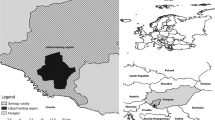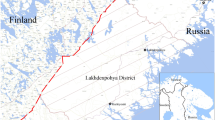Abstract
In animals, exposure to metal pollution can induce oxidative stress via several mechanisms. This stress might then cause adverse effects on functions such as male reproductive capacity. Antioxidant vitamins A and E play an important role in maintaining organism functions under stressed conditions. This study assessed the effect of different metals and metalloids on levels of vitamins A and E in livers and testis (n = 67 and 36) of red deer and in livers (n = 22) of wild boar. The study compared animals residing within and outside a polluted mining area. Red deer from mined areas showed significant reductions in liver retinyl docosahexaenoate and retinyl docosapentaenoate. Free retinol, α-tocopherol, and retinyl palmitate in the testis were also lower. This might indicate that increased internal usage of these antioxidants is occurring as deer try to maintain the integrity and function of reproductive tissue. Wild boar from mined areas also showed significant reductions in liver retinyl stearate but increased free retinol levels. This might suggest that vitamin A is being mobilized to a greater degree to cope with the induced oxidative stress caused by exposure to metal pollution. Additionally, a significant negative relationship between liver α-tocopherol and bone lead (Pb) in boar might indicate some long-term effects of Pb on antioxidant levels. Results suggest that vitamin A and E status can be altered as a consequence of exposure to Pb pollution and that complex differences in this response probably exist between species.



Similar content being viewed by others
References
Alpsoy L, Yildirim A, Agar G (2009) The antioxidant effects of vitamin A, C, and E on aflatoxin B1-induced oxidative stress in human lymphocytes. Toxicol Ind Health 25(2):121–127
Azzi A, Ricciarelli R, Zingg J-M (2002) Non-antioxidant molecular functions of α-tocopherol (vitamin E). FEBS Lett 519(1–3):8–10
Ballet N, Robert JC, Williams PEV (2000) Vitamins in forages. In: Givens DI, Owen E, Axford RFE, Omed HM (eds) Forage evaluation in ruminant nutrition. Cabi Publishing, London
Beyer WN, Gaston G, Brazzle R, O’Connell AF, Audet DJ (2007) Deer exposed to exceptionally high concentrations of lead near the Continental Mine in Idaho, USA. Environ Toxicol Chem 26:1040–1046
Bugalho MN, Milne JA (2003) The composition of the diet of red deer (Cervus elaphus) in a Mediterranean environment: a case of summer nutritional constraits? For Ecol Manage 181(1–2):23–29
Burk RF (2002) Selenium, an antioxidant nutrient. Nutr Clin Care 5(2):75–79
Carranza J, Hidalgo de Trucios SJ, Medina R, Valencia J, Delgado J (1991) Space use by red deer in a Mediterranean ecosystem as determined by radio-traking. Appl Anim Behav Sci 30(3–4):363–371
Castellanos P, Reglero MM, Taggart MA, Mateo M (2010) Changes in fatty acid profiles in testis and spermatozoa of red deer exposed to metal pollution. Reprod Toxicol 29:346–352
Cemeli E, Baumgartner A, Anderson D (2009) Antioxidants and the Comet assay. Mutat Res - Rev Mutat 681:51–67
Chaurasia SS, Kar A (1997) Protective effects of vitamin E against lead-induced deterioration of membrane associated type-I iodothyronine 5′-monodeiodinase (5′D-I) activity in male mice. Toxicology 124:203–209
Chow CK (2009) Role of vitamin E in cellular antioxidant defense. Curr Chem Biol 3(2):197–202
Curtin F, Schulz P (1998) Multiple correlations and Bonferroni’s correction. Biol Psychiatry 44(8):775–777
Dragsted LO (2008) Biomarkers of exposure to vitamins A, C, and E and their relation to lipid and protein oxidation markers. Eur J Nutr 47:3–18
Hevia P (2003) El Patrimonio Minero del Valle de Alcudia y Sierra Madrona. Mancomunidad de Municipios del Valle de Alcudia y Sierra Madrona. Ciudad Real, Spain
Hoffman DJ, Rattner BA, Scheunert I, Korte F (2001) Environmental contaminants. In: Shore RF, Rattner BA (eds) Ecotoxicology of wild mammals. Wiley, Chichester
Hsu PC, Guo YL (2002) Antioxidant nutrients and lead toxicity. Toxicology 180:33–44
Humann-Ziehank E, Ganter M, Hennig-Pauka I, Binder A (2008) Trace mineral status and blood parameters in sheep without mineral supply compared to local roe deer (Capreolus capreolus) populations. Small Ruminant Res 75:185–191
Jurczuk M, Brzóska MM, Moniuszko-Jakoniuk J (2007) Hepatic and renal concentrations of vitamins E and C in lead- and ethanol-exposed rats. An assessment of their involvement in the mechanisms of peroxidative damage. Food Chem Toxicol 45:1478–1486
Käkelä A, Käkelä R, Hyvärinen H (2002) Analysis of hepatic vitamins A1, A2, their fatty acyl esters, and vitamin E for biomonitoring mammals feeding on freshwater fish. Environ Toxicol Chem 21:390–396
Kefer JC, Agarwal A, Sabanegh E (2009) Role of antioxidants in the treatment of male infertility. Int J Urol 16:449–457
Keuling O, Stier N, Roth M (2008) Annual and seasonal space use of different age classes of female wild boar Sus scrofa L. Eur J Wildl Res 54(3):403–412
Lee SA, Belyaeva OV, Kedishvili NY (2008) Effect of lipid peroxidation products on the activity of human retinol dehydrogenase 12 (RDH12) and retinoid metabolism. Biochim Biophys Acta 1782(6):421–425
Majchrzak D, Fabian E, Elmadfa I (2006) Vitamin A content (retinol and retinyl esters) in livers of different animals. Food Chem 98:704–710
Mateo R, Beyer WN, Spann JW, Hoffman DJ, Ramis A (2003) Relationship between oxidative stress, pathology, and behavioural signs of lead poisoning in mallards. J Toxicol Environ Health A 66(14):1371–1389
Mos L, Tabuchi M, Dangerfield N, Jeffries SJ, Koop BF, Ross PS (2007) Contaminant-associated disruption of vitamin A and its receptor (retinoic acid receptor α) in free-ranging harbour seals (Phoca vitulina). Aquat Toxicol 81(3):319–328
Murk AJ, Leonards PEG, van Hattum B, Luit R, van der Weiden MEJ, Smit M (1998) Application of biomarkers for exposure and effect of polyhalogenated aromatic hydrocarbons in naturally exposed European otters (Lutra lutra). Environ Toxicol Pharmacol 6:91–102
Murvoll KM, Skaare JU, Anderssen E, Jenssen BM (2006) Exposure and effects of persistent organic pollutants in European Shag (Phalacrocorax aristotelis) hatchling from the coast of Norway. Environ Toxicol Chem 25(1):190–198
Nyman M, Bergknut M, Fant ML, Raunio H, Jestoi M, Bengs C, Murk A, Koistinen J, Bäckman C, Pelkonen O, Tysklind M, Hirvi T, Helle E (2003) Contaminant exposure and effects in Baltic ringed and grey seals as assessed by biomarkers. Mar Environ Res 55:73–99
Oppenheimer R (2001) Vitamins. In: Robbins CT (ed) Wildlife feeding and nutrition, 2nd edn. Academic Press, San Diego, pp 81–109
Paiva SAR, Russell RM, Dutta SK (1999) β-Carotene and other carotenoids as antioxidants. J Am Coll Nutr 18(5):426–433
Palero-Fernández FJ, Martín-Izard A (2005) Trace element contents in galena and sphalerite from ore deposits of the Alcudia Valley mineral field (Eastern Sierra Morena, Spain). J Geochem Explor 86:1–25
Patrick L (2006) Lead toxicity, part II: the role of free radical damage and the use of antioxidants in the pathology and treatment of lead toxicity. Altern Med Rev 11(2):114–127
Puls R (1994) Vitamin levels in animal health: diagnostic data and bibliographies, 2nd edn. Sherpa International, Clearbrook
Reglero MM, Monsalve-González L, Taggart MA, Mateo R (2008) Transfer of metals to plants and red deer in an old lead mining area in Spain. Sci Total Environ 406:287–297
Reglero MM, Taggart MA, Monsalve-González L, Mateo R (2009a) Heavy metal exposure in large game from a lead mining area: effects on oxidative stress and fatty acid composition in liver. Environ Pollut 157:1388–1395
Reglero MM, Taggart MA, Castellanos P, Mateo R (2009b) Reduced sperm quality in relation to oxidative stress in red deer from a lead mining area. Environ Pollut 157:2209–2215
Rodríguez-Estival J, Martínez-Haro M, Martín-Hernando MP, Mateo R (2010) Sub-chronic effects of nitrate in drinking water on red-legged partridge (Alectoris rufa): oxidative stress and T-cell mediated immune function. Environ Res 110:469–475
Rolland RM (2000) A review of chemically-induced alterations in thyroid and vitamin A status from field studies of wildlife and fish. J Wildl Dis 36(4):615–635
Ross DA (1998) Vitamin A and public health: challenges for the next decade. Proc Nutr Soc 57:159–165
Shan G, Tang T, Zhang X (2009) The protective effect of ascorbic acid and thiamine supplementation against damage caused by lead in the testes of mice. J Huazhong Univ Sci Technol Med Sci 29(1):68–72
Sharma RK, Agrawal M (2005) Biological effects of heavy metals: an overview. J Environ Biol 26(2):301–313
Simms W, Ross PS (2000) Vitamin A physiology and its application as biomarker of contaminant-related toxicity in marine mammals: a review. Toxicol Ind Health 16:291–302
Spear PA, Bourbonnais DH, Peakall DB, Moon TW (1989) Dove reproduction and retinoid (vitamin A) dynamics in adult females and their eggs following exposure to 3,3′,4,4′-tetrachlorobuphenyl. Can J Zool 67(4):908–913
Spear PA, Bourbonnais DH, Norstrom RJ, Moon TW (1990) Yolk retinoids (vitamin A) in eggs of the herring gull and correlations with polychlorinated dibenzo-p-dioxins and dibenzofurans. Environ Toxicol Chem 9(8):1053–1061
Taggart MA, Reglero MM, Camarero PR, Mateo R (in press) Should legislation regarding maximum Pb and Cd levels in human food also cover large game meat? Environ Int doi:10.1016/j.envint.2010.06.007
Valko M, Morris H, Cronin MTD (2005) Metals, toxicity and oxidative stress. Curr Med Chem 12(10):1161–1208
Acknowledgments
We thank Pablo Camarero and Lidia Monsalve for their help with the laboratory work and Manuel Reglero and Mª Dolors Vidal for their help with field sampling. Jaime Rodríguez-Estival was supported by a predoctoral grant from the Junta de Comunidades de Castilla-La Mancha, Spain. This study has been funded by the Department of Education and Science of Junta de Comunidades de Castilla-La Mancha with projects PCC-05-004-2 and PCI08-0096-1295.
Author information
Authors and Affiliations
Corresponding author
Rights and permissions
About this article
Cite this article
Rodríguez-Estival, J., Taggart, M.A. & Mateo, R. Alterations in Vitamin A and E Levels in Liver and Testis of Wild Ungulates from a Lead Mining Area. Arch Environ Contam Toxicol 60, 361–371 (2011). https://doi.org/10.1007/s00244-010-9597-z
Received:
Accepted:
Published:
Issue Date:
DOI: https://doi.org/10.1007/s00244-010-9597-z




